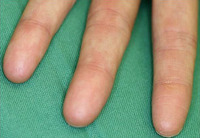Imagine going through customs with everything in order. Passport’s okay, and all seems fine. But when your fingerprints are scanned, the customs agents are looking surprised. Apparently, you have no fingerprints. Sounds weird, right? And yet, it is exactly what happened to a Swiss woman in 2007 when she tried to enter the United States.
As it turned out, the woman had a very rare condition known as adermatoglyphia, leading to a lack of fingerprints (see figure 1), and a lower production of hand sweat than the average person. Very little is known about the condition, and so far, only four families carrying the mutation have ever been documented.

Figure 1: No fingerprints.
(Source: Nousbeck et al., 2011)
In order to learn more about this condition, dermatologists from the Tel Aviv Sourasky Medical Center in Israel, Tel Aviv University, and the University Hospital in Basel, Switzerland, collected DNA from the family. When comparing the genomes of family members with the condition to those of family members without it, differences were found in 17 regions. Sequencing genes, however, did not lead to the identification of a culprit.
Was the analysis flawed? Or was the mutation hiding in ‘junk DNA’? After going through databases of rare DNA transcripts, a very short sequence was identified that partly overlapped with the gene SMARCAD1. After sequencing the gene, it was found that this gene was different in family members without fingerprints. The mutation, however, was not found in the regions of the gene that code for the protein, but rather near a key splicing site, thereby preventing the SMARCAD1 protein from being formed correctly.
Now, the researcher are planning to take a closer look at the function of this gene, which is still a mystery. The idea is that it might help skin cells fold over each other during early fetal development.
Luckily, none of these affected families ever had the idea to start a crime syndicate...
Reference
Nousbeck, J.; Burger, B.; Fuchs-Telem, D.; Pavlovsky, M.; Fenig, S.; Sarig, O.; Itin, P.and Sprecher, E. (2011). A Mutation in a Skin-Specific Isoform of SMARCAD1 Causes Autosomal-Dominant Adermatoglyphia. The American Journal of Human Genetics. Doi:10.1016/ajhg.2011.07.004.


